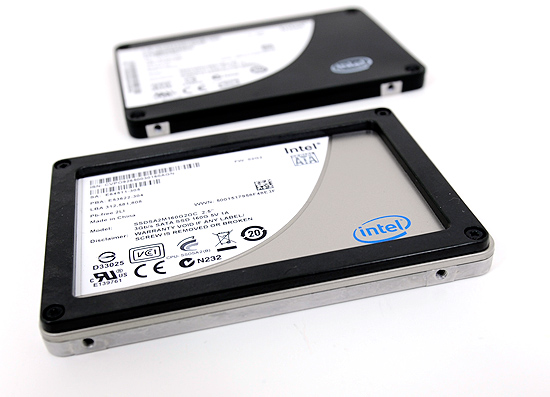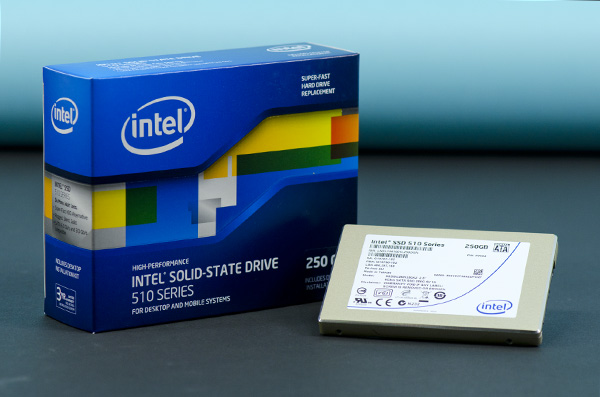The Intel SSD 510 Review
by Anand Lal Shimpi on March 2, 2011 1:23 AM EST- Posted in
- IT Computing
- Storage
- SSDs
- Intel
- Intel SSD 510
The X25-M was a tremendous first attempt by Intel to get into the SSD market. In our review of the SSD I wrote that Intel just Conroe’d the SSD market, and if it weren’t for the pesky 80MB/s sequential write speed limitation the X25-M would’ve been given the title: World’s Fastest Drive.

Its successor, the X25-M G2, was a mild update that brought prices down through the use of 34nm NAND. Remember that Intel is also 49% owner of the IMFT joint venture and as a result can be quite competitive on NAND pricing (and quite early to adopt new NAND technologies).

Intel’s goal all along was to drive down the cost of SSDs. Looking at the history of MSRPs with the X25-M (not to mention the M, which stood for Mainstream in the product name) this shouldn’t come as a surprise:
| Intel X25-M Pricing History | |||||
| 2008 | 2009 | ||||
| 40GB | - | $125 | |||
| 80GB | $595 | $225 | |||
| 160GB | $1000+ | $440 | |||
The third generation X25-M was to drive down costs even further, this time thanks to Intel’s 25nm NAND. You’d be able to get twice the capacity at the same price point as the X25-M G2. The value drive would be an 80GB offering, the mainstream drive would be 160GB and the high end drive would be 320GB.
The drive would offer higher performance. The controller was to be completely redesigned, with the “oversight” that limited sequential write speed to only 100MB/s corrected entirely. In addition, the third generation Intel SSD would add full disk encryption - making it even better suited for enterprise customers. Going after the enterprise market was Intel’s plan to really make money on SSDs in the long run. Instead of just selling corporations a CPU, chipset and wireless controller in a notebook, there would be an SSD on top of all of that. Perhaps eventually even have some security software courtesy of McAfee.
The third generation X25-M was originally due out in the middle of 2010. As is usually the case with schedules, the “G3” slipped. The middle of the year became the end of the year and the end of the year became Q1 2011.
To make matters worse, the specifications Intel was talking about for its third generation drive/controller weren’t all that competitive. We published the details last year knowing that the competition would do better. Intel’s redesigned controller was late and underperforming. Internally, Intel knew it had a problem.
Intel aimed for the majority of the market with the X25-M, it had set its sights on lowering cost, but it left the high performance enthusiast market entirely uncared for. A void that SandForce filled quite nicely with its unique brand of controllers.
With a hole in the roadmap and an unwillingness to cede complete control of the high end market to SandForce, Intel did the unthinkable: developed a new SSD based on a competing controller technology.











128 Comments
View All Comments
TSnor - Wednesday, March 2, 2011 - link
Article says "Write speed with fully incompressible data is easily a victory for the SF-2200 based OCZ Vertex 3. "I think you meant "Write speed with compressible data is easily a victory for the SF-2200 based OCZ Vertex 3. "
Excellent article, I was interested in the 3rd gen intel SSD, but not at these specs. Wish you gave the read latency time (it can be inferred to some degree from the elapsed time charts which are good). Also, given the size of internal cache these devices use perhaps running for more than 3 mins would be a good idea. The average performance is still changing at 3 mins.
AstroGuardian - Wednesday, March 2, 2011 - link
"I mentioned earlier that the 510 would go through Intel’s extensive validation testing, just like any other Intel product."Yea right! Just like the H67 and P67. Yea, that made me so happy.
Anand Lal Shimpi - Wednesday, March 2, 2011 - link
That's 100% a valid point and it does show that even with extensive validation errors can still get through.You'll remember that the X25-M was the first to have major firmware issues before any of its present day competitors were even created.
Only time will tell how well Intel has learned from those experiences and how seriously it's taking the validation of the 510. Initial compatibility testing looks good but we've got a long road ahead of us.
Take care,
Anand
Ryomitomo - Thursday, March 3, 2011 - link
At least Intel's labs identified the problems themselves, disclosed the problem themselves, will recall and exchange to fix the problem.These things makes me feel very confident to buy future Intel products.
Nihility - Thursday, March 3, 2011 - link
A good point. Unlike certain NVIDIA mobile chipsets.Chloiber - Wednesday, March 2, 2011 - link
...I think Anand is right. Many of you are complaining, but as he said on the final page: it is not clear, where the actual limits are for random speeds. Of course, it's always better to have more. The thing is, that your PC at home can't benefit from 60'000 IOPS. It just can't. You can run it through benchmarks which show high numbers, but as soon as you feed the drive and the CPU with real data, the drive is NOT the limiting factor anymore.I'm not saying that it's a good thing the Intel 510 has such low random speeds, compared to other, even older drives. But in the end, the question is whether or not you can actually benefit from 200MB/s random reads and random writes with QDs above 4.
Anand said himself, and I assure you that he is correct - you can trace it yourself if you want - that with standard workload on home desktop PCs, Queue Depth rarely exceeds 1 or 2, especially not with an SSD in your system. Not even during boot!
And now THINK AGAIN. What are the random 4k read speeds for low QD of EVERY SSD today? It's actually limited by the NAND being used and it's between 20MB/s and 30MB/s for EVERY SSD.
Again, I'm not saying that high IOPS aren't important. I'm just saying, they aren't as important as you think. Not anymore, not in the very high regions we are today and especially not with very high QDs.
The 510 seems to have very good performance in real world benchmarks - it seems that most of you rate synthetic benchmarks higher than real world benchmarks. This, I don't quite understand.
semo - Wednesday, March 2, 2011 - link
The fact is, you will not be using a very competitively priced 250GB SSD for net browsing. When I get my SSD, I'll be using it to store my test VMs where I do a lot of software installations and snapshot jumping.The 510 is not a mainstream product where the QD rarely goes above 2. Not at that price at least. I've installed an SSD for a few average users but they were all 60GB drives. I could never justify the price of a 250GB SSD to them but a pro user might (i.e. someone who might make use of a high IOPS drive).
semo - Wednesday, March 2, 2011 - link
Meant to say "uncompetitively". Too expensive for the average computer user.tno - Thursday, March 3, 2011 - link
Spot on, and so a mainstream drive this is not. As workstation drive, however, this seems pretty solid.Nentor - Wednesday, March 2, 2011 - link
If it (the 510) was very cheap everything you say makes sense, but since it is not they'd better make it as fast as possible.